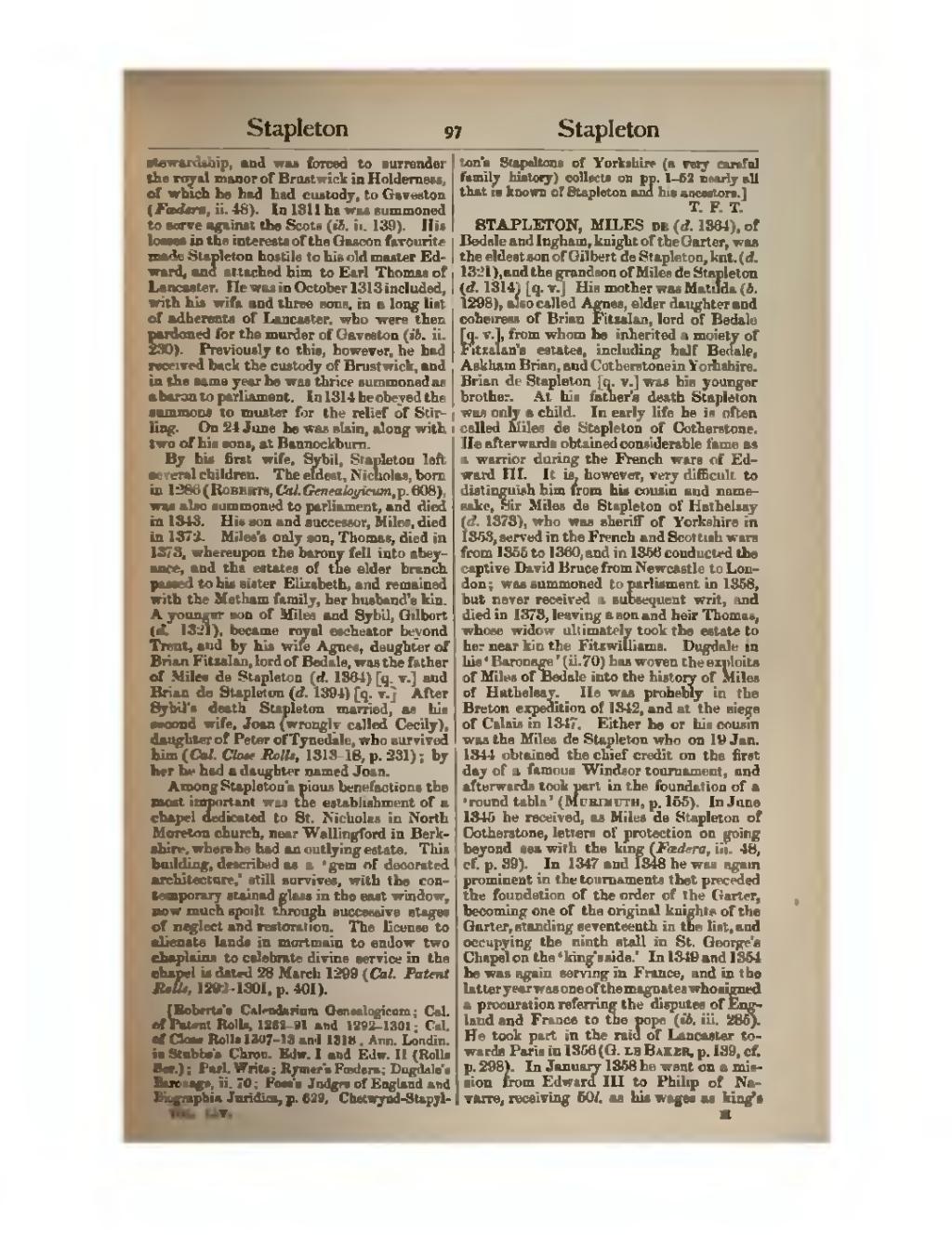stewardship, and was forced to surrender the royal manor of Brustwick in Holderness, of which he had had custody, to Gaveston (Fœdera, ii. 48). In 1311 he was summoned to serve against the Scots (ib. ii. 139). His losses in the interests of the Gascon favourite made Stapleton hostile to his old master Edward, and attached him to Earl Thomas of Lancaster. He was in October 1313 included, with his wife and three sons, in a long list of adherents of Lancaster, who were then pardoned for the murder of Gaveston (ib. ii. 230). Previously to this, however, he had received back the custody of Brustwick, and in the same year he was thrice summoned as a baron to parliament. In 1314 he obeyed the summons to muster for the relief of Stirling. On 24 June he was slain, along with two of his sons, at Bannockburn.
By his first wife, Sybil, Stapleton left several children. The eldest, Nicholas, born in 1286 (Roberts, Cal. Genealogicum, p. 608), was also summoned to parliament, and died in 1343. His son and successor, Miles, died in 1372. Miles's only son, Thomas, died in 1373, whereupon the barony fell into abeyance, and the estates of the elder branch passed to his sister Elizabeth, and remained with the Metham family, her husband's kin. A younger son of Miles and Sybil, Gilbert (d. 1321), became royal escheator beyond Trent, and by his wife Agnes, daughter of Brian Fitzalan, lord of Bedale, was the father of Miles de Stapleton (d. 1364) [q. v.] and Brian de Stapleton (d. 1394) [q. v.] After Sybil's death Stapleton married, as his second wife, Joan (wrongly called Cecily), daughter of Peter of Tynedale, who survived him (Cal. Close Rolls, 1313–18, p. 231); by her he had a daughter named Joan.
Among Stapleton's pious benefactions the most important was the establishment of a chapel dedicated to St. Nicholas in North Moreton church, near Wallingford in Berkshire, where he had an outlying estate. This building, described as a ‘gem of decorated architecture,’ still survives, with the contemporary stained glass in the east window, now much spoilt through successive stages of neglect and restoration. The license to alienate lands in mortmain to endow two chaplains to celebrate divine service in the chapel is dated 28 March 1299 (Cal. Patent Rolls, 1292–1301, p. 401).
[Roberts's Calendarium Genealogicum; Cal. of Patent Rolls, 1282–91 and 1292–1301; Cal. of Close Rolls 1307–13 and 1318; Ann. Londin. in Stubbs's Chron. Edw. I and Edw. II (Rolls Ser.); Parl. Writs; Rymer's Fœdera; Dugdale's Baronage, ii. 70; Foss's Judges of England and Biographia Juridica, p. 629. Chetwynd-Stapylton's Stapeltons of Yorkshire (a very careful family history) collects on pp. 1–52 nearly all that is known of Stapleton and his ancestors.]
STAPLETON, MILES de (d. 1364), of Bedale and Ingham, knight of the Garter, was the eldest son of Gilbert de Stapleton, knt. (d. 1321), and the grandson of Miles de Stapleton (d. 1314) [q. v.] His mother was Matilda (b. 1298), also called Agnes, elder daughter and coheiress of Brian Fitzalan, lord of Bedale [q. v.], from whom he inherited a moiety of Fitzalan's estates, including half Bedale, Askham Brian, and Cotherstone in Yorkshire. Brian de Stapleton [q. v.] was his younger brother. At his father's death Stapleton was only a child. In early life he is often called Miles de Stapleton of Cotherstone. He afterwards obtained considerable fame as a warrior during the French wars of Edward III. It is, however, very difficult to distinguish him from his cousin and namesake, Sir Miles de Stapleton of Hathelsay (d. 1373), who was sheriff of Yorkshire in 1353, served in the French and Scottish wars from 1355 to 1360, and in 1356 conducted the captive David Bruce from Newcastle to London; was summoned to parliament in 1358, but never received a subsequent writ, and died in 1373, leaving a son and heir Thomas, whose widow ultimately took the estate to her near kin the Fitzwilliams. Dugdale in his ‘Baronage’ (ii. 70) has woven the exploits of Miles of Bedale into the history of Miles of Hathelsay. He was probably in the Breton expedition of 1342, and at the siege of Calais in 1347. Either he or his cousin was the Miles de Stapleton who on 19 Jan. 1344 obtained the chief credit on the first day of a famous Windsor tournament, and afterwards took part in the foundation of a ‘round table’ (Murimuth, p. 155). In June 1345 he received, as Miles de Stapleton of Cotherstone, letters of protection on going beyond sea with the king (Fœdera, iii. 48, cf. p. 39). In 1347 and 1348 he was again prominent in the tournaments that preceded the foundation of the order of the Garter, becoming one of the original knights of the Garter, standing seventeenth in the list, and occupying the ninth stall in St. George's Chapel on the ‘king's side.’ In 1349 and 1354 he was again serving in France, and in the latter year was one of the magnates who signed a procuration referring the disputes of England and France to the pope (ib. iii. 285). He took part in the raid of Lancaster towards Paris in 1356 (G. le Baker, p. 139, cf. p. 298). In January 1358 he went on a mission from Edward III to Philip of Navarre, receiving 50l. as his wages as king's
